Related Research Articles

The Polyporaceae are a family of poroid fungi belonging to the Basidiomycota. The flesh of their fruit bodies varies from soft to very tough. Most members of this family have their hymenium in vertical pores on the underside of the caps, but some of them have gills or gill-like structures. Many species are brackets, but others have a definite stipe – for example, Polyporus badius.
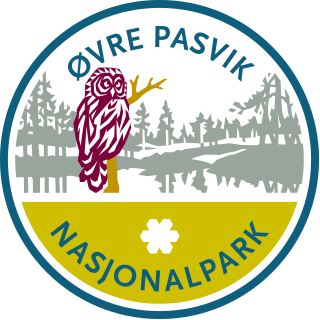
Øvre Pasvik National Park is located in the southeastern part of the Pasvikdalen valley in southern Sør-Varanger Municipality in Finnmark county, Norway. Covering an area of 119 square kilometers (46 sq mi), the national park is dominated by Siberian-like taiga consisting of old-growth forests of Scots pine, shallow lakes and bog. Proposals for a national park in Øvre Pasvik were first launched in 1936, but the park was not created until 6 February 1970. It originally covered 66 square kilometers (25 sq mi), but was expanded on 29 August 2003. Øvre Pasvik is part of Pasvik–Inari Trilateral Park along with the adjacent Øvre Pasvik Landscape Protection Area, the joint Norwegian and Russian Pasvik Nature Reserve, and Finland's Vätsäri Wilderness Area.
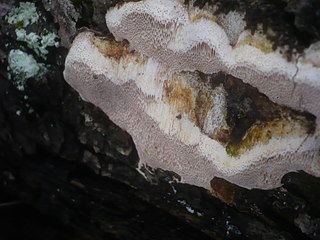
Perenniporia is a cosmopolitan genus of bracket-forming or crust-like polypores in the family Polyporaceae. They are dimitic or trimitic with smooth, thick-walled basidiospores and cause a white rot in affected wood.

The Steccherinaceae are a family of about 200 species of fungi in the order Polyporales. It includes crust-like, toothed, and poroid species that cause a white rot in dead wood.

Auriporia is a small genus of four species of poroid fungi in the family Fomitopsidaceae.
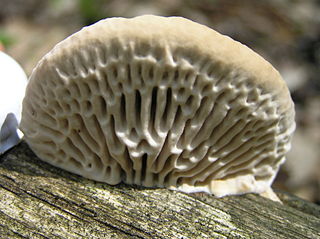
Daedalea is a genus of fungi in the family Fomitopsidaceae. The genus was circumscribed in 1801 by mycologist Christian Hendrik Persoon, based on the type D. quercina and four other species. The generic name is derived from the Ancient Greek δαιδαλεος.
Leif Randulff Ryvarden is a Norwegian mycologist.

Mycoaciella is a genus of corticioid fungi in the family Meruliaceae. The genus was circumscribed by John Eriksson and Leif Ryvarden in 1978. After microscopic examination of the three species then in the genus, Karen Nakasone proposed to synonymize Mycoaciella with Phlebia.

Meruliopsis is a genus of poroid crust fungi. The genus was circumscribed by Russian mycologist Appollinaris Semenovich Bondartsev in 1959.

Ceriporia is a widely distributed genus of crust fungi.

Antrodiella is a genus of fungi in the family Steccherinaceae of the order Polyporales.
Humphreya is a genus of four species of polypore fungi in the family Ganodermataceae. The genus was circumscribed by Belgian mycologist René Léopold Steyaert in 1972. He proposed Humphreya as a genus segregate from Ganoderma, typified by Ganoderma lloydi Pat. & Har., and included Ganoderma coffeatum and the newly described Humphreya endertii. H. eminii was transferred to the genus by Leif Ryvarden in 1980.

Coriolopsis is a genus of fungi in the family Polyporaceae. It was circumscribed by American mycologist William Alphonso Murrill in 1905. The genus is cosmopolitan, with most species in tropical areas. The generic name combines the name Coriolus with the Ancient Greek word ὄψις ("appearance").
Grammothele is a genus of poroid crust fungi in the family Polyporaceae.

Hapalopilus is a genus of poroid fungi in the family Polyporaceae. The genus is widely distributed. The generic name combines the Ancient Greek words ἁπαλός ("tender") and πιλος ("cap"). Hapalopilus was circumscribed by Finnish mycologist Petter Adolf Karsten in 1881.
Navisporus is a genus of seven species of tropical poroid fungi in the family Polyporaceae. It was circumscribed by Norwegian mycologist Leif Ryvarden in 1980 with Navisporus floccosus as the type species. This fungus, first described as Trametes floccosa by Giacomo Bresadola in 1896, is thought to have been originally collected in Tanzania.

Tyromyces is a genus of poroid fungi in the family Polyporaceae. It was circumscribed by mycologist Petter Karsten in 1881. The type species is the widely distributed Tyromyces chioneus, commonly known as the white cheese polypore. The phylogenetic position of Tyromyces within the Polyporales is uncertain, but it appears that it does not belong to the "core polyporoid clade". Tyromyces is polyphyletic as it is currently circumscribed, and has been described as "a dumping place for monomitic white-rot species with thin-walled spores."
Wrightoporia is a genus of fungi in the family Bondarzewiaceae. According to a 2008 estimate, the widely distributed genus contains 23 species. The genus was circumscribed by Zdeněk Pouzar in Ceská Mykol. vol.20 on page 173 in 1966.
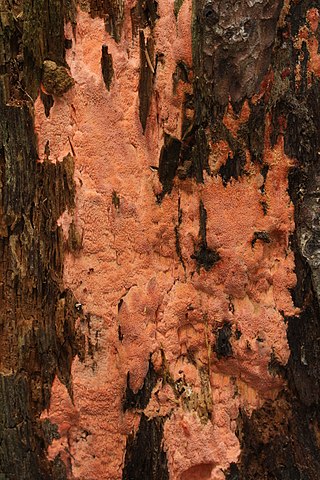
Rhodonia is a fungal genus in the family Fomitopsidaceae. It is a monotypic genus, containing the single crust fungus Rhodonia placenta. A brown rot species, R. placenta is found in China, Europe, and North America, where it grows on decaying conifer wood.
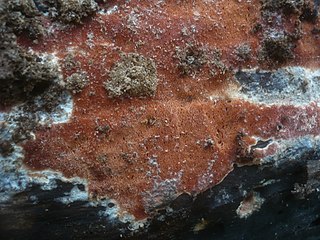
Ceriporia purpurea is a species of crust fungus in the family Irpicaceae. It was first described by Swedish mycologist Elias Magnus Fries in 1821 as Polyporus purpureus. Marinus Anton Donk gave the fungus its current name when he transferred it to the genus Ceriporia in 1971.
References
- ↑ Ryvarden L, Johansen I. (1980). A preliminary polypore flora of East Africa. Oslo, Norway: Fungiflora. p. 276.
- ↑ "Ceriporia xylostromatoides (Berk.) Ryvarden 1980". MycoBank. International Mycological Association. Retrieved 2012-03-28.